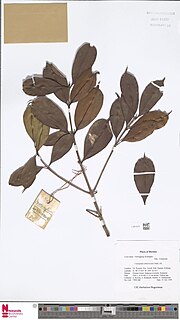
Cratoxylum arborescens is a plant in the family Hypericaceae. The specific epithet arborescens is from the Latin meaning "tree-like".
Canarium littorale is a tree found in tropical Asia and is a member of the incense tree family Burseraceae. The specific epithet littorale is from the Latin meaning "of the seashore", referring to its habitat.
Mastixia glauca is a tree in the family Nyssaceae. The specific epithet glauca is from the Greek meaning "bluish-grey", referring to the colour of the leaf underside.
Mastixia macrocarpa is a tree in the family Nyssaceae. The specific epithet macrocarpa is from the Greek meaning "large fruit".
Dysoxylum densiflorum is a tree in the family Meliaceae. The specific epithet densiflorum is from the Latin meaning "dense flowers".
Dysoxylum excelsum is a tree in the family Meliaceae. The specific epithet excelsum is from the Latin meaning "tall".
Xanthophyllum vitellinum is a plant in the family Polygalaceae. The specific epithet vitellinum is from the Latin meaning "egg-yolk yellow", referring to the colour of the flower petals.
Canarium dichotomum is a tree in the family Burseraceae. The specific epithet dichotomum is from the Latin meaning "forked", referring to the branching of the inflorescences.
Canarium denticulatum is a tree in the family Burseraceae. The specific epithet denticulatum is from the Latin meaning "small teeth", referring to the leaf margin.

Dacryodes rostrata is a tree in the family Burseraceae. The specific epithet rostrata is from the Latin meaning "beaked", referring to the narrow-tipped leaves.
Dacryodes rugosa is a tree in the family Burseraceae. The specific epithet rugosa is from the Latin meaning "wrinkled", referring to the leaflets.
Mastixia eugenioides is a tree in the family Nyssaceae. The specific epithet eugenioides is from the Latin and refers to the resemblance of the leaves to those of the genus Eugenia.
Mastixia pentandra subsp. scortechinii is a subspecies of Mastixia pentandra. It is a tree in the family Nyssaceae. It is named for the botanist Benedetto Scortechini.
Mastixia rostrata subsp. caudatifolia is a subspecies of Mastixia rostrata. It is a tree in the family Nyssaceae. The infraspecific epithet caudatifolia is from the Latin meaning "tapered leaf".
Mastixia trichotoma is a tree in the family Nyssaceae. The specific epithet trichotoma is from the Greek meaning "three parts", referring to the three-branched inflorescence.
Anacolosa frutescens, also known as galo or galonut, is a plant in the family Olacaceae. The specific epithet frutescens is from the Latin frutex meaning "shrub". It produces edible fruits and nuts eaten in the Philippines.

Melicope accedens is a plant in the family Rutaceae.
Melicope glabra is a tree in the [family Rutaceae. The specific epithet glabra is from the Latin meaning "hairless".
Buchanania insignis is a tree of Borneo in the cashew and sumac family Anacardiaceae. The specific epithet insignis is from the Latin meaning "remarkable".
Castanopsis javanica, the Javan chestnut-oak, is a tree in the beech family Fagaceae. The specific epithet javanica is from the Latin, meaning "of Java".


